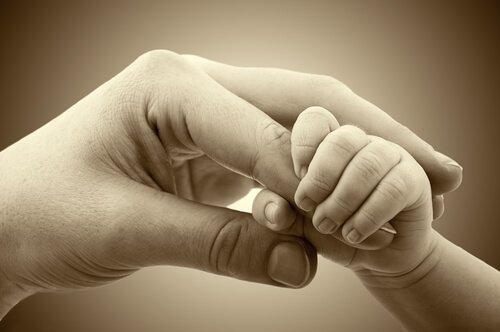The Neurobiology of Human Attachment

Attachment is a defining characteristic of mammals. Thus, research on the neurobiology of human attachment is also based on animal research. Recent studies suggest that attachment is based on the interaction of oxytocin and dopamine in the corpus striatum.
What seems fairly certain is that different human attachments share the neurobiology in the attachments they’re based on. In general, they’re characterized by the synchronicity between behavior and the integration of the cortical and subcortical networks involved in reward and motivation mechanisms, incorporated simulation, and mentalization.
The Neurobiology of Human Attachment
According to Ruth Feldman, a researcher on the neurobiology of human attachment, we should study attachment in mammals from a developmental perspective. Thus, the associative cerebral cortex is connected by early upbringing experiences in children ages two to four.
The attachments that come later, such as romantic partners or close friends, reuse the basic machinery that was established in the initial attachment between mother and child during early “sensitive periods”.
Researchers define these “sensitive periods” as early and specific windows of time when the brain experiences certain environmental contributions in order to mature properly. In the context of attachment, these involve the typical rearing behavior of the species.

Human Attachment Neurobiology Models Proposals
In her research, Dr. Feldman brought together different proposals on the neurobiology of human attachment:
- As we said above, research on human attachment should follow a developmental perspective. Thus, neurobiological systems would support the bond between two mammals. The mother and her descendent make up this relationship during the early sensitive periods of life (6).
- The continuity in neurobiological systems sustains the human connection. Human attachments reuse the basic machinery established by the parent-child bond to form other attachments over a lifetime (such as romantic relationships or close friendships (7).
- Human bonds are selective and long-lasting. Bonds are the goal of attachment and they can last your whole life (1).
- Attachment is based on behavior triggered by the expression of behavior patterns specific to a species, society, or individual. Bonding involves top-down processes. Attachment-related behavior activates the brain and neuroendocrine systems (4, 8).
- The synchronicity of biological behavior is a key trait of human attachment. In other words, the connection between non-verbal behavior and the coordinated physiological response between two individuals during social contact are what characterize human attachment (9).
- The central role of the oxytocin system and the dopamine-oxytocin connection are involved in human maternity. They also have to do with paternity, co-parenting, romantic attachment, and close friendship. The integration of oxytocin and dopamine in the corpus striatum soak attachments with motivation and vitality (10).

More Theories
- Forming bonds involves greater activity and a stricter interference between the relevant systems. During periods of attachment formation, you can see the activation of the tightest relationships between the systems that support affiliation, reward, and stress management (11).
- Human attachments promote homeostasis, health, and well-being. Social attachments improve health and happiness. Social isolation, on the other hand, increases stress, is detrimental to your health, and can cause death (12).
- Attachment patterns transfer from one generation to the next. Behavior patterns that you experience in your early life organize the availability of oxytocin and the localization of the receptor in a baby’s brain. Thus, it basically programs the ability to raise the next generation (13, 14).
- The mother-child attachment and the proximity of the mother make up the organ that is the brain. This allows it to function within the social ecology. The immature brain of a baby mammal and the need to be close to a mother who breastfeeds the brain as an organ that constantly responds to the social environment (15).
- The bonds that you experience over the course of your life are transformative. Healthy bonds that you form later in life can actually repair negative relationships from your early years. The plasticity of the human brain and the fact that its nature is based on behavior allows later attachments to actually reorganize the neural networks and repair, at least in part, early negative experiences (16).
In conclusion, it seems that the foundation of human attachment neurobiology is the interactions between oxytocin and dopamine in the brain. It would also seem that these cerebral systems form during infant attachment. Thus, it’s interesting to know that these systems are recycled later on to form other attachments, such as friendship or love.
Attachment is a defining characteristic of mammals. Thus, research on the neurobiology of human attachment is also based on animal research. Recent studies suggest that attachment is based on the interaction of oxytocin and dopamine in the corpus striatum.
What seems fairly certain is that different human attachments share the neurobiology in the attachments they’re based on. In general, they’re characterized by the synchronicity between behavior and the integration of the cortical and subcortical networks involved in reward and motivation mechanisms, incorporated simulation, and mentalization.
The Neurobiology of Human Attachment
According to Ruth Feldman, a researcher on the neurobiology of human attachment, we should study attachment in mammals from a developmental perspective. Thus, the associative cerebral cortex is connected by early upbringing experiences in children ages two to four.
The attachments that come later, such as romantic partners or close friends, reuse the basic machinery that was established in the initial attachment between mother and child during early “sensitive periods”.
Researchers define these “sensitive periods” as early and specific windows of time when the brain experiences certain environmental contributions in order to mature properly. In the context of attachment, these involve the typical rearing behavior of the species.

Human Attachment Neurobiology Models Proposals
In her research, Dr. Feldman brought together different proposals on the neurobiology of human attachment:
- As we said above, research on human attachment should follow a developmental perspective. Thus, neurobiological systems would support the bond between two mammals. The mother and her descendent make up this relationship during the early sensitive periods of life (6).
- The continuity in neurobiological systems sustains the human connection. Human attachments reuse the basic machinery established by the parent-child bond to form other attachments over a lifetime (such as romantic relationships or close friendships (7).
- Human bonds are selective and long-lasting. Bonds are the goal of attachment and they can last your whole life (1).
- Attachment is based on behavior triggered by the expression of behavior patterns specific to a species, society, or individual. Bonding involves top-down processes. Attachment-related behavior activates the brain and neuroendocrine systems (4, 8).
- The synchronicity of biological behavior is a key trait of human attachment. In other words, the connection between non-verbal behavior and the coordinated physiological response between two individuals during social contact are what characterize human attachment (9).
- The central role of the oxytocin system and the dopamine-oxytocin connection are involved in human maternity. They also have to do with paternity, co-parenting, romantic attachment, and close friendship. The integration of oxytocin and dopamine in the corpus striatum soak attachments with motivation and vitality (10).

More Theories
- Forming bonds involves greater activity and a stricter interference between the relevant systems. During periods of attachment formation, you can see the activation of the tightest relationships between the systems that support affiliation, reward, and stress management (11).
- Human attachments promote homeostasis, health, and well-being. Social attachments improve health and happiness. Social isolation, on the other hand, increases stress, is detrimental to your health, and can cause death (12).
- Attachment patterns transfer from one generation to the next. Behavior patterns that you experience in your early life organize the availability of oxytocin and the localization of the receptor in a baby’s brain. Thus, it basically programs the ability to raise the next generation (13, 14).
- The mother-child attachment and the proximity of the mother make up the organ that is the brain. This allows it to function within the social ecology. The immature brain of a baby mammal and the need to be close to a mother who breastfeeds the brain as an organ that constantly responds to the social environment (15).
- The bonds that you experience over the course of your life are transformative. Healthy bonds that you form later in life can actually repair negative relationships from your early years. The plasticity of the human brain and the fact that its nature is based on behavior allows later attachments to actually reorganize the neural networks and repair, at least in part, early negative experiences (16).
In conclusion, it seems that the foundation of human attachment neurobiology is the interactions between oxytocin and dopamine in the brain. It would also seem that these cerebral systems form during infant attachment. Thus, it’s interesting to know that these systems are recycled later on to form other attachments, such as friendship or love.
All cited sources were thoroughly reviewed by our team to ensure their quality, reliability, currency, and validity. The bibliography of this article was considered reliable and of academic or scientific accuracy.
-
Feldman, R. (2017). The neurobiology of human attachments. Trends in Cognitive Sciences, 21(2), 80-99.
-
Rilling, J. K. (2014). Comparative primate neuroimaging: insights into human brain evolution. Trends in cognitive sciences, 18(1), 46-55.
-
Kundakovic, M., & Champagne, F. A. (2015). Early-life experience, epigenetics, and the developing brain. Neuropsychopharmacology, 40(1), 141.
-
Feldman, R. (2015). The adaptive human parental brain: implications for children’s social development. Trends in neurosciences, 38(6), 387-399.
-
Feldman, R. (2015). Sensitive periods in human social development: New insights from research on oxytocin, synchrony, and high-risk parenting. Development and Psychopathology, 27(2), 369-395.
-
Carter, C. S. (2014). Oxytocin pathways and the evolution of human behavior. Annual review of psychology, 65, 17-39.
-
Feldman, R. (2016). The neurobiology of mammalian parenting and the biosocial context of human caregiving. Hormones and Behavior, 77, 3-17.
-
Feldman, R. (2012). Oxytocin and social affiliation in humans. Hormones and behavior, 61(3), 380-391.
-
Feldman, R. (2012). Bio-behavioral synchrony: A model for integrating biological and microsocial behavioral processes in the study of parenting. Parenting, 12(2-3), 154-164.
-
Love, T. M. (2014). Oxytocin, motivation and the role of dopamine. Pharmacology Biochemistry and Behavior, 119, 49-60.
-
Ulmer-Yaniv, A., Avitsur, R., Kanat-Maymon, Y., Schneiderman, I., Zagoory-Sharon, O., & Feldman, R. (2016). Affiliation, reward, and immune biomarkers coalesce to support social synchrony during periods of bond formation in humans. Brain, behavior, and immunity, 56, 130-139.
-
Cacioppo, J. T., Cacioppo, S., Capitanio, J. P., & Cole, S. W. (2015). The neuroendocrinology of social isolation. Annual review of psychology, 66, 733-767.
-
Weaver, I. C., Cervoni, N., Champagne, F. A., D’Alessio, A. C., Sharma, S., Seckl, J. R., … & Meaney, M. J. (2004). Epigenetic programming by maternal behavior. Nature neuroscience, 7(8), 847.
-
Feldman, R. (2007). Mother‐infant synchrony and the development of moral orientation in childhood and adolescence: Direct and indirect mechanisms of developmental continuity. American Journal of Orthopsychiatry, 77(4), 582-597.
-
Akers, K. G., Yang, Z., DelVecchio, D. P., Reeb, B. C., Romeo, R. D., McEwen, B. S., & Tang, A. C. (2008). Social competitiveness and plasticity of neuroendocrine function in old age: influence of neonatal novelty exposure and maternal care reliability. PloS one, 3(7), e2840.
-
Schore, A. N. (2013). Relational trauma, brain development, and dissociation. Treating complex traumatic stress disorders in children and adolescents: Scientific foundations and therapeutic models, 3-23.
This text is provided for informational purposes only and does not replace consultation with a professional. If in doubt, consult your specialist.







